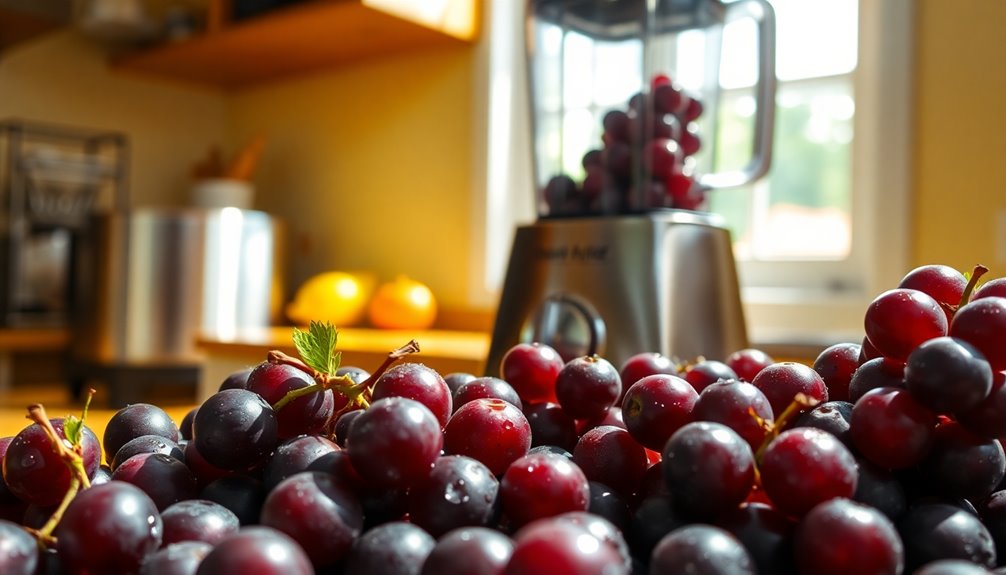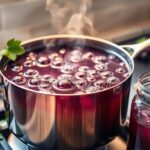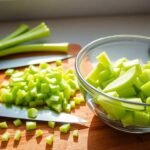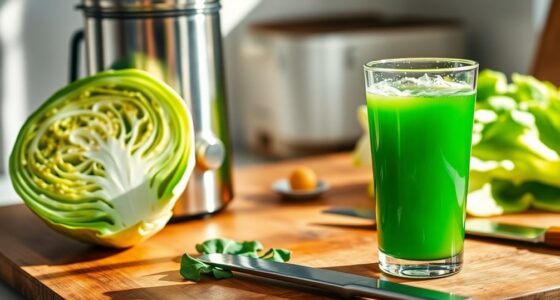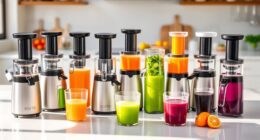To make grape juice with a blender, start by rinsing and removing stems from 1 pound of seedless California grapes. Add half a cup of water, then blend on high for at least a minute until smooth. Pour the mixture through a fine-mesh sieve and press down with a spatula to extract juice, leaving behind the pulp. Store the juice in an airtight container in the fridge for up to 5-7 days. Keep exploring for tips on customization and storage!
Key Takeaways
- Rinse 1 pound of seedless California grapes and remove stems before blending.
- Blend grapes with half a cup of water on high for at least one minute.
- Strain the blended mixture using a fine-mesh sieve to extract juice without pulp.
- Store fresh grape juice in an airtight container in the refrigerator for 5-7 days.
- Customize sweetness by adding honey or agave syrup according to personal preference.
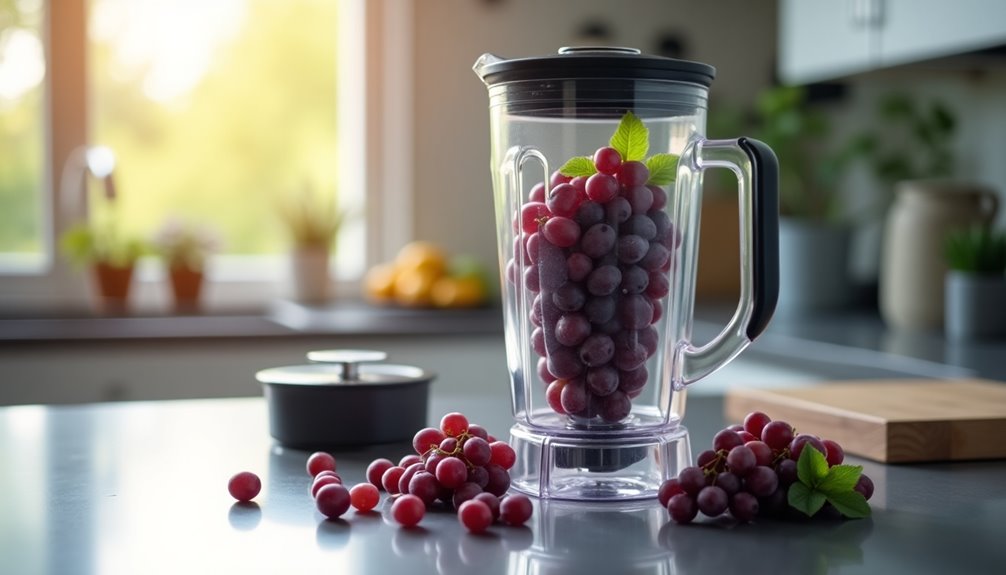
Making grape juice at home is a simple and rewarding process that only takes a few minutes. You can enjoy the incredible flavor of fresh grape juice without any added sugars or preservatives. With just a few ingredients and a blender, you'll be sipping on delicious homemade grape juice in no time.
Start by rinsing a pound of seedless California grapes thoroughly under cold water. Take your time with this step; it's essential to remove any dirt or contaminants. Once the grapes are clean, remove the stems, as they aren't needed for the juice.
Now, it's time to make grape juice! Place the prepared grapes into your blender, and to help achieve your desired consistency, add about half a cup of water. The water will aid in blending the grapes smoothly and ensure you get the most juice out of them.
Next, blend the grapes on high for at least one minute. This step is crucial; you want to blend until smooth, ensuring that the grapes are fully pureed. You'll notice the vibrant color and aroma of the fresh grape juice beginning to fill your kitchen.
After blending, it's time to strain the mixture. Grab a fine-mesh sieve and place it over a bowl or pitcher. Pour the blended grape mixture into the sieve, using a spatula or the back of a spoon to press down on the solids. This helps extract as much juice as possible, resulting in a clearer juice without any pulp.
Now that you've got your fresh grape juice, you can choose to store it or enjoy it right away. If you decide to store the fresh grape juice, transfer it into an airtight container and place it in the refrigerator. It'll stay good for about 5-7 days, but for the best flavor, it's certainly recommended to drink it fresh.
One of the best things about making homemade grape juice is that you can adjust it to your liking. If you want a sweeter drink, you can add a touch of honey or agave syrup, but many people enjoy the natural sweetness of the grapes themselves. This is a great way to avoid any added sugars found in store-bought juices.
Frequently Asked Questions
How Can I Make Juice With a Blender?
To make juice with a blender, start by choosing your favorite fruits or vegetables.
Wash and chop them into smaller pieces, then place them in the blender. Add a splash of water to help with blending.
Blend on high until smooth, usually about a minute.
Next, strain the mixture through a fine-mesh sieve to separate the juice from the pulp.
Sweeten if needed, then enjoy your fresh juice right away!
What Is the Best Way to Extract Juice From Grapes?
To extract juice from grapes, start by rinsing them and filling your blender jar about three-quarters full.
Add a splash of water to help with blending. Blend on high for at least one minute until the grapes break down completely.
After blending, strain the mixture through a fine-mesh sieve to separate the juice from the pulp, pressing down on the solids to get as much liquid as possible. The resulting juice can be enjoyed fresh, but if you’re interested in learning how to prepare juice concentrate, you’ll want to simmer the strained liquid in a saucepan over low heat. This will help evaporate excess water, intensifying the flavor and resulting in a thicker consistency. Once the desired concentration is reached, cool it down before storing it in airtight containers for later use. You can experiment with different fruits or vegetable combinations to create unique flavors that suit your palate. Additionally, consider adding natural sweeteners, such as honey or agave syrup, during the simmering process to enhance the taste of your juice concentrate. For those curious about how to prepare juice concentrate, this method not only preserves the freshness of your ingredients but also allows you to create a versatile product that can elevate a variety of drinks and recipes.
Adjust sweetness to your taste if needed.
Can You Put Grapes With Seeds in a Blender?
You can definitely put grapes with seeds in a blender, but you might want to think about the texture and taste.
If you blend them, you'll get a grainy juice that may have a hint of bitterness. If you're after smoothness, you'd be better off with seedless grapes.
Blending seeded grapes isn't unhealthy, but straining the juice afterward can help enhance its overall flavor and make it more enjoyable.
Why Do You Add Baking Soda to Grape Juice?
You might add baking soda to grape juice for a smoother taste by neutralizing acidity, which reduces bitterness.
It can also enhance the juice's color, making it more appealing.
When you mix baking soda with grape juice, you'll notice a fizzy reaction from the carbon dioxide released, adding a unique texture.
However, use it sparingly, since too much can alter the flavor and lead to an unpleasant taste in your juice.
Conclusion
In just a few simple steps, you've created a delicious, delightful drink! With your trusty blender, you've transformed fresh, flavorful grapes into a gorgeous glass of grape juice. Sip and savor the sweet satisfaction of your homemade beverage. Remember, with a little creativity and care, you can craft countless concoctions. So, keep blending and exploring, and let your kitchen be a canvas for colorful creations. Cheers to your juicing journey!
Cindy thoroughly researches juicing trends, techniques, and recipes to provide readers with practical advice and inspiration. Her writing style is accessible, engaging, and designed to make complex concepts easy to understand. Cindy’s dedication to promoting the advantages of juicing shines through her work, empowering readers to make positive changes in their lives through the simple act of juicing.

